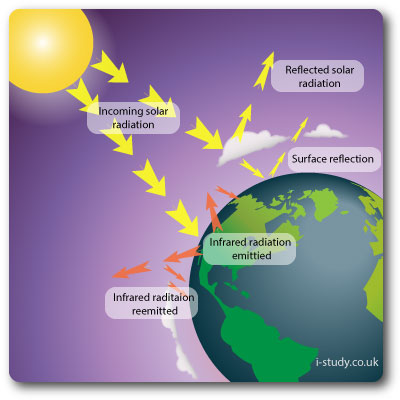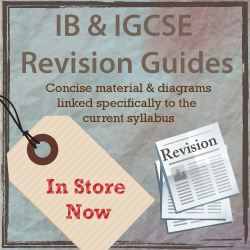Global Warming

The Greenhouse Effect
Incoming solar radiation enters the earths atmosphere. Some is reflected by clouds and some more is reflected by atmospheric pollution.
On reaching the earths surface some of the light is reflected depending on the albedo rate (ice sheets, oceans etc).
The rest is used by plants (photosynthesis) or absorbed by the land and oceans. This heats the land and oceans with the heat being released into the atmosphere as longwave infrared radiation.
The greenhouse gases trap some of this infrared radiation in the atmosphere and reemit it back towards earth. Increases in the levels of greenhouse gases in the atmospher increase the amount being reemitted back in the atmposphere.
The Greenhouse Gases
Greenhouse gases exist naturally in the atmosphere playing a vital role in creating the climate that has enabled us to exist.
Global Dimming
Global dimming is the term used to descride the trend of less sunlight reaching the earths surface. Records show that this has been occuring in many regions of the world over the last 50 or more years.
Cause: the amount of solar radiation entering the atmosphere has not substantailly changed, rather the amount reflected back into space has increased. Increased atmospheric pollution has resulted in dramatic increases in the pollution particles in the air. Some of these reflect or absorb sunlight and stop it reaching the earth, but they are also changing the formation of clouds. Pollution particles act as nuclei for condensation and cloud formation, the result of which is more clouds and bigger clouds which are reflecting more sunlight.
Global dimming is reducing the energy reaching the earths surface and so having a cooling effect on the climate. This could be argued to be countering the process of global warming slightly. The problem appears to lie in that by reducing greenhouse gas emissions we would reduce cloud formation and increase the solar energy reaching the earth - enhancing the rate of climate change. Northern Europe has reduced its emisions and has experienced falls in the level of global dimming.
Global Pollution management Strategies
Kyoto Protocol (1997): This was the initial agreement between industrialised nations to reduce greenhouse gas emissions. This was a major step forward in global pollution management and reduction as countries ste trgets and laid out plans as ti how to achieve them. Unfortunately the agreements were not legally binding and some of the most polluting countries failed to reduce their emissions.
Cap & Trade: This is the concept that countries and firms have limit (cap) for the amount of emissions that they can emitt. Countries or firms that exceed this would need to purchase the unused quota from other countries/firms. This would create a marketplace for trading carbon emmissions etc and place a value on the pollution. Cleaner nations and businesses would make money and dirty ones would be financially penalised. Through this mechanism there would be great financial incentive to reduce pollution and invest in clean technologies and energy resources. The allowed quota could be reduced year on year to slowly reduce overall emissions.
Carbon Taxes: Taxing each unit of greehouse gas produced adds an extra costs to production based on how polluting the firm is. Firms could reduce the amount of tax they pay by reducing greenhouse emissions and so a large incentive for change is created. The problem with this aproach is that there needs to be an agreed value for emissions to base the tax on. Also firms could decide to just pay the tax rather than actually reduce emissions.



